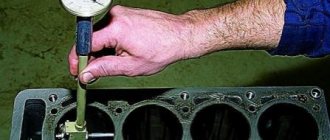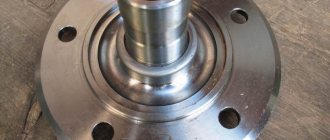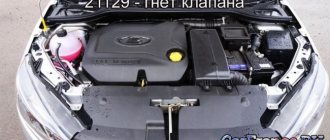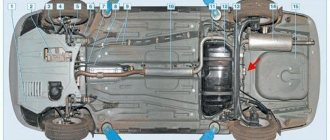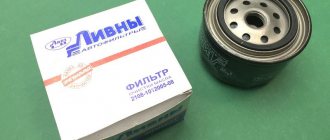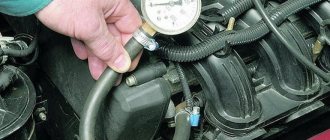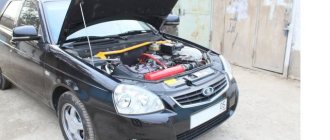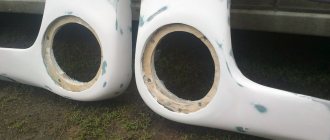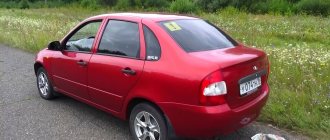see also
Comments 44
What kind of piston was installed, whose production? Name?
Hello, I’m installing the piston 126th 82.5, I want to assemble it on the Prior’s cylinder head gasket, won’t the valve bend if the belt breaks?
Having become the piston recesses and becoming a metal package gasket. Everything will be fine
I had a Priora 222000, but 3 days ago a problem happened at 155 speed, either a piston pin or a piston broke, the head was removed, there was a bare connecting rod in the 3rd cylinder, the piston was in the trash, and there was a hole in the block opposite the 4th
Such a question: Priora car, Connecting rods 124 After a thorough overhaul, 20 tons went through. Ditonation began after 6 tons. Oil changed every 5 tons. Mobile oil 10 to 40. At 20 tons. I drove from the countryside and pressed decently. And at that moment the traction disappeared, the revolutions began to drop, from the rear. smoke screen. The temperature was normal. I stopped, opened the hood, oil squeezed out from the dipstick, the car was shaking and stalling. Somehow I got home at 40 kph and it didn’t flare up anymore. At home I unscrewed the spark plugs. In cylinder 2 there is a spark plug in metal shavings. What is the reason? How much will the repair cost? By the way, this happened after refueling 30 km. After refueling, a ringing sound appeared after 4 tons of revolutions. Maybe the fuel is not of good quality?
Hi all! Tell me, I want to make capital, 126 engine. Which pistons are better to choose with which group? What does Stoda need for the piston group? Some people are talking about ten pistons, others about Priora FM pistons. If you set the decimals, then do you need to change the connecting rods? I also don’t want to overpay... What pistons can be installed on the original connecting rods? Please advise something, dear prior leaders. This is the first time I’ve encountered such a problem, simply as a major overhaul... Thanks in advance.
Install black edition
Hi all! Tell me, I want to make capital, 126 engine. Which pistons are better to choose with which group? What does Stoda need for the piston group? Some people are talking about ten pistons, others about Priora FM pistons. If you set the decimals, then do you need to change the connecting rods? I also don’t want to overpay... What pistons can be installed on the original connecting rods? Please advise something, dear prior leaders. This is the first time I’ve encountered such a problem, simply as a major overhaul... Thanks in advance.
If you don’t want to change the connecting rods, then if you became a 10 piston, I would install Priorov’s ones, I would already install STK dick expert super piston
Hi all! Tell me, I want to make capital, 126 engine. Which pistons are better to choose with which group? What does Stoda need for the piston group? Some people are talking about ten pistons, others about Priora FM pistons. If you set the decimals, then do you need to change the connecting rods? I also don’t want to overpay... What pistons can be installed on the original connecting rods? Please advise something, dear prior leaders. This is the first time I’ve encountered such a problem, simply as a major overhaul... Thanks in advance.
Now I’m assembling an engine also using Kostroma pistons on my Priora. Do you remember how many hundred parts were made for the thermal gap of the piston-cylinder?
honestly - I don't remember
Now I’m assembling an engine also using Kostroma pistons on my Priora. Do you remember how many hundred parts were made for the thermal gap of the piston-cylinder?
and where is the manufacturer’s description of the spare parts you took?
Greetings! How are things going with the engine at the moment? Did you remove the block to bore it? I'm also going to invest
I sold the car to a friend and he is tearing it up in its tail and mane. Doesn't eat oil, pistons don't rattle. after capitalization the car has already run more than 80k
The pistons also started knocking at 120 thousand, we changed the pistons, the knocking went away, but the oil began to burn. Now it’s 160 thousand and the pistons are knocking again... I’ve been thinking for a long time whether to set it to 124 or to risk sticking it in at 126 again. I decided to put 124, because... the master seems to have been caught with a ball and says that it will work even better, but there are tricks) In general, they installed 124, punched the catalyst, reflashed and voila))) It’s tearing right away, I’ll say it’s better than on 126, in my opinion, acceleration has become more dynamic and easier, zhor oil is gone. And most importantly, for a long time. So if you just set it, it will be a little worse to drive than 126, but for anyone, someone won’t even notice. You punch the catalytic converter and flash it and it goes better) and most importantly for a long time! I am surprised at our manufacturers, it seems that garage craftsmen are much more competent than these VAZ engineers who make engines up to 100 thousand. Yes, the new Priora drives briskly, but not for long!)))) Fortunately, spare parts and repairs are cheap.
It seems to me that there are 124 pistons, I bought the car after a major overhaul, everything was replaced, the piston connecting rods, etc. the question is, if there are 124 pistons, what kind of gasoline can be poured in? AI92
AI 95 is everywhere. Although you can flash the ecu for 124 shg, for driving on AI92.
I found out that they supplied me with lightweight plugless pistons with a displacement combustion chamber
Engine valves on Priora
Lada Priora is a restyling of the VAZ 2110. These cars were equipped with 8-valve engines with a displacement of 1.5 liters, later modifications with 1.6 liters appeared. On them, when the timing belt breaks, the valves do not meet the pistons and do not bend. One and a half liter engines with 16 valves began to be installed on the VAZ 2112, and they also migrated to the Priora. For the first time, owners of such cars were faced with the issue of valve bending when the timing belt broke. It's all about the design features. The cylinder head is now equipped with 16 valves, power increases to 92 hp. pp., but at the same time bending the valves leads to a major overhaul.
On a 16-valve engine, the pistons do not have special grooves; as a result, if the valve timing is disrupted, they will bend the valves. Later models of Lada Priora were equipped with a 16-valve 1.6-liter engine. Here the pistons had recesses. Such a power unit is installed on Priora today. Contrary to the statement of the valve manufacturer, it still bends, but much less often. This probability is observed only at high speeds. A belt break that is twice as wide as a standard 1st family belt is uncommon. If you use a low-quality belt, the likelihood of bending increases sharply, and repairs will be priced an order of magnitude higher than similar work on an 8-valve engine.
Return to contents
Repairing engine 21126 VAZ 2170 Priora after timing belt break
Today we brought one of the old clients to the Priora, as it turned out, the jammed pump broke the belt and, as a result, the valves were bent.
But progress at AvtoVAZ does not stand still, and if on the engines of the tenth family the valves were simply bent, then on the Priora 126s the connecting rods also lose alignment and, if they are not changed, there is a high probability that the engine will begin to eat oil and, accordingly, your money. Glory to the designers of AvtoVAZ!
But every cloud has a silver lining, there are sets of pistons for 126 engines with grooves that do not bend the valves. In this article we will describe the procedure for repairing the cylinder head after a broken timing belt, as well as replacing the piston. Removing and installing the timing belt is described in this article, so we will not dwell on it in detail.
Engine disassembly and repair
Repairs are carried out according to the standard procedure - we find faulty parts and replace them with working ones. The instructions below describe the process of disassembling the unit itself; before that, you need to dismantle it from the Lada Priora and thoroughly clean it of grease and dirt.
From the tools we will need regular and ring wrenches, a ratchet with an extension, screwdrivers, a pry bar and a stand. It is best to carry out repairs in a garage with good lighting.
Instructions
- Using the 13th key, remove the bracket fastenings. 4 nuts hold the front cylinder block support;
- We remove the bracket and move on to the left support - it is removed in exactly the same way;
Thus, you can completely disassemble the 16-valve engine and repair and replace faulty parts. But if the unit bends the valve, then only an experienced mechanic can handle the malfunction with his own hands. In any case, you will find out whether the motor bends the valves or not after removing the head cover.
Let's start to disassemble
First, drain the oil and antifreeze. We remove the protective cover, the air filter with pipes, disconnect the ignition coil connectors, the throttle cable and the throttle assembly.
We remove the thermostat housing and simultaneously disconnect all the available connectors and pipes. We remove all the wiring that was in our way towards the battery.
We remove the generator. We unscrew the eight thirteen nuts holding the intake manifold and remove it. We unscrew all the bolts securing the valve cover, as well as the side engine support.
Unscrew the eight nuts and remove the exhaust manifold.
Remove the timing belt, camshaft pulleys and pump.
In three passes, so as not to deform the part, we first loosen and then unscrew twenty bolts of the camshaft bearing housing, the head is eight. Be sure to follow the sequence shown in the photo.
Remove the bearing housing. We remove the camshafts; there is a distinctive lip on the intake camshaft.
Also, in several passes, we first loosen and then unscrew the ten cylinder head mounting bolts. Be sure to follow the sequence shown in the photo.
Remove the cylinder head. All sixteen valves are replaced.
Cylinder head repair
We mark all hydraulic compensators with numbers using an ordinary clerical touch and put them away. An ordinary magnet will help you pull them out. We dry out the valves and remove the oil seals (valve seals), the valves into scrap metal, the oil seals into the trash. We clean all channels. We take the head for grinding, just in case. After washing it again with kerosene after sanding and blowing it with air, we begin to assemble it.
We arrange the freshly purchased valves in the sequence in which they will stand in the cylinder head and begin to grind in one by one. Lubricate the valve stem with clean oil and apply lapping paste to the edge.
We insert the valve into place and put a valve grinding tool on the valve stem. The stores sell a device for manual lapping, but since this is the twenty-first century, we are mechanizing the process. We take the old valve and cut off the rod from it, select a rubber tube for it of such a diameter that it fits tightly. The rod is in a reversible drill, one end of the tube is on it, the other is on the valve being ground in. At low speeds we begin to grind the valve, constantly change the direction of rotation and periodically press it to the seat or weaken the force. On average, the valve takes about twenty seconds. We take it out and wipe it. The valve is considered ground in if a uniform gray strip of at least 1.5 mm wide appears on the chamfer.
The same stripe should appear on the valve seat.
Video of manually grinding valves
For a sixteen valve head, everything is the same, only there are twice as many valves.
After lapping, all valves and seats are thoroughly wiped and washed with kerosene to remove any remaining lapping paste. We check for leaks. We tighten the old spark plugs and put all the valves in place. Pour kerosene and wait three minutes, if the kerosene does not run away all is well, otherwise we grind the valves on this cylinder.
We had to grind four valves again, after which the kerosene stopped flowing.
We stuff new valve seals.
We put the valves in place and dry them. Before doing this, lubricate the valve stems with clean oil. After lubricating it with clean oil, we put the hydraulic compensators in place and, covering them with a clean cloth, remove the head out of sight. We're done with the cylinder head.
Let's move on to the cylinder block
We remove the pallet. Rotating the crankshaft as it is convenient for us, unscrew two bolts on each connecting rod cap. We use a TORX E10 head for this.
We take out the pistons along with the connecting rods. To do this, use the wooden handle of a hammer to press the connecting rod from below and lightly tap it to knock it up. We remove the old liners and buy new ones of the same size according to the markings on them. Here is another stone in AvtoVAZ’s garden, the owner has never climbed into the car from the interior or into the engine, but three pistons were of group “B” and one was “C”. It turns out that at the factory they re-sharpened one cylinder a little and simply put an enlarged piston there, no words. There are no options, we take group “C”, don’t sharpen the engine because of this. We will not touch the main liners either.
We buy a new piston group that does not bend the valves, connecting rods and connecting rod bearings.
Eliminating longitudinal play of the crankshaft
It was noticed on this motor. To eliminate it, replace the thrust half-rings. Standard and repair sizes are available. We take the first repair size, if they are too tight we sand them down a little. We unscrew the middle main bearing and gently push it with a screwdriver and move the half rings. The mark on it is in the form of three serifs, shown below.
When the half ring comes out a little, turn the crankshaft, it will push it out. There are two types of half rings: white at the front and yellow at the rear; the grooves on them should point towards the crankshaft cheeks.
We install them as we removed the new half rings; if they go in with great effort, you can grind them a little on a small abrasive stone, but not from the side of the grooves. Checking the play. We tighten the main bearing with a torque of 8 kgf*m.
Assembling the piston
There is an arrow stamped on the top of the piston; it should be directed towards the front of the engine. And there are marks on the connecting rod that should look the same way. Don't get confused!
We insert one retaining ring into the groove on the piston. We insert the connecting rod into the piston and, having lubricated the connecting rod and the piston pin with oil, insert it into place. Insert the second retaining ring. Although this operation seems simple, it will take some pains. We inspect the assembled structure; all retaining rings must be clearly in their grooves, otherwise a ring that has jumped out while the engine is running can cause a lot of trouble.
After assembly, you need to break off the connecting rod bearing cap, since the connecting rod is made in one piece. It's like that on our cars. First, unscrew the bolts. We insert the connecting rod into the cleats at the level of the mark shown in the figure with the black arrow and lightly clamp it, then break it off with a slight movement of the hand. The first time is very scary. We put the cover in place and tighten the bolts so as not to mix it up in the future.
Checking the thermal gap in the piston rings
We lay out each set of rings for each cylinder. In the future we will not change their places. In turn, we insert each ring into its own cylinder and push it a little with the piston approximately to the middle.
We measure the gap with feeler gauges.
Nominal clearance: 0.25 - 0.45 mm.
The maximum clearance for all is 1 mm. But this already smacks of waste.
Installing new rings
First, install the oil scraper ring expansion spring, then the ring itself. The oil scraper ring lock should face the opposite direction of the spring lock. Then we install the lower compression ring and finally the upper compression ring. The inscription “TOP” must be stamped on the rings; it must face up. The rings in the piston grooves must rotate easily.
Repair stages
Priora engine repair begins with disassembly.
To do this, you need to have screwdrivers and wrenches, an assembly blade, torque wrenches, a soft hammer, and a device for installing the pistons.
The algorithm of actions is as follows:
- First you need to disassemble the motor. This will not be difficult, but all actions must be performed slowly and carefully.
- First of all, you should remove all accumulated carbon deposits that are located in the area where the cylinders are located. It is imperative to remove carbon deposits located in the oil grooves in the area of the cylinder beds.
- After this, you need to insert the bearing shells. In this case, you should focus on the marks that were made during the disassembly of the motor. The locking-type antennae of the liners must fit exactly into the grooves that are in the beds. You definitely need to keep an eye on this.
- Now you should coat the liners with oil.
- Next, you need to install the crankshaft in the cylinder block. Then the half rings are lubricated with oil. When installing, you need to check that the grooves on them are directed precisely towards the crankshaft cheeks.
- Then you need to install half rings, which are made of a compound of aluminum and steel. They are distinguished by a white tint. Installation is carried out on the front side in a bed located centrally.
- On the other hand, a metal-ceramic ring needs to be secured to the bed. It has a yellowish tint.
- Next, the half rings, which are already installed, need to be rotated so that the ends of the parts are located at the end of the cylinder bed.
- Now you need to mount the bearings (root) of the liners into the covers. Again you need to look at the marks that were made when the unit was disassembled. You need to make sure that the locking type antennae fit exactly into the grooves. Then the liners need to be well lubricated.
- After this, the covers are installed. Be sure to look at the numbering of them and the cylinder.
- Then you need to coat the threads on the bolts and the ends where the covers will be secured with engine oil.
- Then the third cover is used, and the bolts are tightened again. The same should be done with the bolts on the 3, 4 and 5 covers. Moreover, everything must be carried out in exactly this sequence.
- When all the bolts are tightened, you need to check how easily the crankshaft moves. To do this, turn it several times.
- Then the oil pump is installed and fixed. After this, you need to do the same with the holder for the oil seal located at the rear.
- A connecting rod is installed in the piston. And then the piston pin is inserted. Be sure to oil both the connecting rod itself and the pin.
- Install retaining rings. Check that they are in the grooves.
- Then the oil scraper ring and the piston ring are installed. It is best to have special equipment for such manipulations. The tool is called a puller.
- You need to check that the ring can rotate freely.
- Wipe the connecting rod journals located on the crankshaft. The same applies to the cylinder mirrors.
- A liner is installed in the connecting rod, and the antennae must be exactly located in the connecting rod. The piston and liner need to be lubricated, and then a compression ring must be installed. The connecting rod is lowered into the cylinder.
- The mandrel must be attached to one side. Next, use a regular hammer handle to push the piston.
- The connecting rod head should be mounted to the crankshaft journal area.
- Insert the cover and secure it. Make sure that the markings on the bottom and on the roof are clearly on the same side.
- All the bolts are tightened, and then all the other pistons are installed.
- Secure the oil receiver.
- Install the flywheel and plate. Be sure to first use an anaerobic type clamp to secure the bolts.
- A layer of lubricant is applied.
- An oil sump is installed.
Engine assembly
We wipe the crankshaft journals, cylinder bores and connecting rod bearing seats with a clean rag; by the way, they can also be degreased. We put new liners into the connecting rod and the cover, so that the antennae of the liners fit into the grooves.
Lubricate the bearings, crankshaft journals and cylinders with clean oil. We unfold the piston rings with locks as shown in the figure, the angle between them should be 120 degrees.
We put a mandrel on the piston to compress the rings, having previously lubricated it inside with clean oil. Not forgetting about the direction, the arrow on the piston should be directed towards the front of the engine, we place it in its cylinder.
We turn the crankshaft so that the connecting rod journal is at the very bottom. Gently tapping the wooden handle of a hammer pushes the piston into the cylinder. We remove the mandrel and push the piston down until the connecting rod sits on the crankshaft. We put the connecting rod bearing cap on the bottom, remembering the marks. Tighten the connecting rod cover mounting bolts to a torque of 5 kgf*m. We also repeat with all the other cylinders.
We put back everything that we removed from below. We blow through the top and clean the holes for the cylinder head mounting bolts. We install a new cylinder head gasket and the head itself. Lubricate the bolts with a thin layer of oil, most importantly without fanaticism. We tighten the bolts in several passes in the reverse order of unscrewing, see photo at the beginning of the article. The tightening sequence is as follows:
- first tighten everything with a torque of 2 kgf*m
- then we tighten everything to a torque of 7 – 8 kgf*m
- turn it 90 degrees
- turn it 90 degrees again
We install hydraulic compensators, camshafts and camshaft bearing caps. Lubricate all rubbing surfaces with clean oil. Before installing the camshaft bearing caps, lubricate the perimeter and rims around the spark plug wells with a thin layer of sealant. We tighten the bearing cover bolts in the reverse order of unwinding, with a torque of 2 kgf*m, see photo at the beginning. Well, then we install all the parts in the reverse order of removal. We fill in all the fluids and start it, it may not start right away, this is normal. When you first start it will smoke well until the oil on the cylinders burns, make sure the oil pressure light goes out. Let it run for a minute and turn it off, and suddenly see where something is leaking. We start it several more times, constantly increasing the operating interval, bring it to operating temperature, constantly checking the oil and antifreeze, and also pay attention to the fact that no extraneous noise appears. Let it rest for an hour and then idle again for about an hour, constantly monitoring the temperature. Well, then the break-in, if you sharpened it, if not, then you can drive only the first thousand kilometers, try not to raise the speed above 3000, and not tow it.
What spare parts are needed
Consider the list of spare parts for major repairs of the power unit:
- Piston group kit, it includes pistons, piston rings, piston pin. If the block is sleeved or such a need arises, then sleeves are purchased accordingly. When purchasing a piston group, there is no need to rush; you must first take the block to where you are going to sharpen it, and only after measuring the master will tell you what type of repair the piston needs to be purchased.
- It's a matter of desire; if you want, you can purchase pistons with recesses, especially useful if you are experimenting with split gears, etc. And the chain, despite its reliability, can break once every 20 years and then the meeting of the pistons with the valves is inevitable.
- Main and connecting rod bearings are purchased after the crankshaft has been ground. After grinding the crankshaft, the master will tell you which bearings you need to buy - 0.25, 0.50, 0.75, 1. This depends on the degree of wear of the crankshaft. It is better to take original earbuds.
- Oil pump. This matter is quite controversial, but I prefer to change it when conducting capital. Many people say that it can last for a very long time - I don’t take into account such stories, do it like that.
- Camshaft I also recommend replacing it, but if finances are really bad, you can postpone replacing it, but this is not very advisable. Although if the camshaft is in good condition, you can leave it.
- The intermediate shaft (drive shaft of auxiliary units, pig) is the shaft that rotates the distributor and the oil pump and is driven by a motor chain. This shaft greatly affects the pressure in the lubrication system - if the bushings are heavily worn, the oil pressure drops significantly. When overhauling an engine, the bushings must be replaced, processed with reamers, and the shaft is also either ground or replaced with a new one. There is also an intermediate shaft on ball bearings; this, in addition to increasing the service life of the industrial shaft, also allows you to increase the pressure in the lubrication system. From all this, it is necessary to take away that at the time of sending the block for grooving, you need to purchase a new one or take with you an old washer so that you can replace the bushings and grind the shaft (if you leave the old one), at least this is the case with us.
- If the cylinder head is also being repaired, then it is necessary to purchase valves, valve seals, and springs (if the old ones do not hold the force).
- I also recommend replacing the entire motor chain tensioning system, as well as the motor chain itself, this includes: crankshaft, camshaft, shaft sprockets, motor chain, motor chain tensioner shoe, motor chain tensioner, motor chain damper. Beware of fakes, there have been cases when the motor chain tensioner shoe was made of non-oil resistant rubber and it collapsed quite quickly. I try to install a plastic damper, since even if it breaks, it may not harm the engine as much as a rubber-metal one.
- The crankshaft seals, rear and front, must be replaced.
- You also need to purchase a set of gaskets, you can buy all paper gaskets separately, and buy them separately for the pan, valve cover and under the cylinder head.
- Also check the bearing, which includes the gearbox input shaft, at the end of the crankshaft. If there is play in the bearing, it must be replaced.
- If the engine knocks or the connecting rod bearing turns, then the connecting rod must be replaced.
- Also, do not forget about all the consumables - oil, filter, coolant.
Motor 126 and 127: working life, differences
These engines on Priora had a displacement of 1.6 liters (or 1596 cm3). Optimal for city sedans, the engine size of the Lada Priora gave a good combination of dynamics and consumption: along with very decent acceleration, fuel consumption does not exceed sky-high numbers. Both engines received good marks, because the car behaved perfectly in the city and on the highway.
In fact, the 126 Priora engine became the first sixteen-valve engine for this model, and the 127 is a modified version, “overclocked” by AvtoVAZ designers. In addition to the same engine displacement, they have other identical characteristics. The in-line type of arrangement of four cylinders provides a simplified design that can be repaired on your own.
The distributed multipoint injection system is involved in creating a good, rich fuel-air mixture (a lean mixture can lead to breakdowns). The cylinder diameter is 82 mm, the piston stroke is 75.6 mm, the compression ratio is 11. The “engines” fall under the Euro 4 standard, they are powered by gasoline with an octane rating of 95.
The 126 engine for the Priora received the following characteristics: 98 hp. (72 kW at 5600 rpm), acceleration to 100 km/h in 11.5 seconds (with manual transmission), city consumption 9.1 l - 100 km (manual transmission), maximum torque - 145 Nm.
The 127 engine for the Priora was upgraded to the following figures: 106 hp. (78 kW at 5800 rpm), acceleration to 100 km/h in 11.5 seconds (with manual transmission), city consumption 8.9 liters per 100 km (with manual transmission), maximum torque – 148 Nm.
The difference may not seem so noticeable, but this is a very small but strong step in design on the part of AvtoVAZ (this is where the change to sixteen-valve “engines” with a volume of 1.6 liters ended). For a car of the Lada Priora class, the engine power was sufficient.
In the same block it is necessary to say about the operating temperature. An absolutely normal operating temperature is considered to be between 90 and 95 degrees Celsius. Further, when the car is being pushed in a traffic jam, is basking in the sun, or for some other reason, but can still work - from 97 to 110 degrees. The engine is slow in places and wears out a lot, but you can still get to your destination. A temperature below 90 degrees is a direct sign indicating that the car has not yet warmed up, and it is better to wait in place until the arrow points to the coveted 80-90 mark.
Operating a car at temperatures above 110 degrees is dangerous because the service life of the engine is noticeably reduced - hot parts undergo very severe wear, overcoming the force of friction.
In general, the service life of the Lada Priora engine with a normal driving style and careful treatment is 200,000 km - after this mark the time comes when the “engine” requires major repairs. AvtoVAZ mentioned the timing belt separately as a recommendation, saying that it needs to be checked every 100,000 km (many car enthusiasts talk about the figure of 50,000 km).
All Lada engines have a problem, and it is related to the valves, which will be discussed further.
Malfunctions and repairs of the Priora 21126 engine
The 21126 engine is a continuation of the VAZ 21124 ten-wheel drive engine, but with a 39% lighter ShPG produced by Federal Mogul, the holes for the valves have become smaller, and a different timing belt with an automatic tensioner, thanks to which the problem of tightening the belt on the 124 block has been solved. The Priora engine block itself has also undergone minor changes, such as better surface treatment, and cylinder honing is now carried out in accordance with the more stringent requirements of Federal Mogul. On the same block above the clutch housing there is a place with the Priora engine number; to see it, you need to remove the air filter and arm yourself with a small mirror. Engine VAZ 21126 1.6 l. injection in-line 4-cylinder with overhead camshafts, the gas distribution mechanism is belt driven. The service life of the 21126 Priora engine, according to the manufacturer’s data, is 200 thousand km, how long does the engine run in practice... depending on your luck, on average this is approximately the case. In addition, there is a lightweight version of this engine - Kalina engine 1.4 VAZ 11194, as well as a sports forced version - VAZ0 hp engine, an article about it is HERE. Among the disadvantages of this power unit, it is worth noting unstable operation, loss of power, timing belt. The reasons for unstable operation and refusal to start may be problems with fuel pressure, timing faults, faulty sensors, air leaks through hoses, or a malfunction of the throttle valve. Loss of power may be due to low compression in the cylinders due to a burnt-out gasket, wear of the cylinders, piston rings, or burnt-out pistons. A significant drawback is that the Priora 21126 engine bends the valves. The solution to the problem is to replace the pistons with plugless ones. However, the Priora engine is currently one of the most advanced domestic engines, perhaps the reliability is worse than that of the 124th, but the engine is also very good and powerful enough for comfortable movement in the city. In 2013, a modernized version of this engine was released, the marking of the new VAZ 21127 Priora engine, an article about it is HERE.
In 2015, production of the NFR sports engine began, called 21126-81, which used the 21126 base. And since 2021, cars with 1.8 liter engines 21179, which also used the 126th block, are available.
The most basic malfunctions of the 126 engine
Let's move on to the malfunctions and shortcomings, what to do if the Priora engine is running rough, sometimes flushing the injectors solves the problem, it may be the spark plugs or the ignition coil, but the usual thing in this case is to measure the compression in order to eliminate the problem of valve burnout. But the cheapest option is to go to a service center for diagnostics. Another common problem is when the engine speed of the Priora 21126 fluctuates and the engine runs unevenly, a common disease of VAZ sixteen valves, your mass air flow sensor is dead! Not dead? Then clean the throttle valve, there is a possibility that the TPS (throttle position sensor) needs to be replaced, perhaps the IAC (idle air regulator) has arrived. What to do if the car does not warm up to operating temperature, there may be a problem with the thermostat or the frost is too severe, then you will have to put cardboard on the radiator grill

